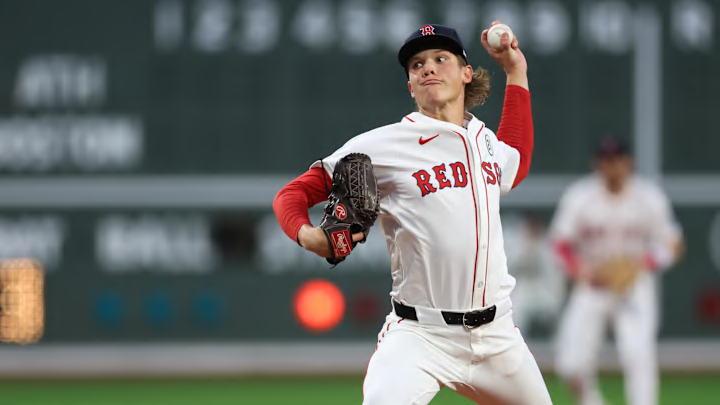This group of young Boston Red Sox arms is the best and brightest in at least a generation, if not longer. Not all of them will ultimately fulfill their promise at the major league level, but they represent a marked improvement from the failed classes of the late 2000s and early 2010s. This turn in fortune reflects a change in organizational philosophy that already promises to pay off at the major league level.
First, let’s look at several of the failed Red Sox prospects to understand what the Red Sox preferred in their young pitchers.
Former Red Sox Pitching Prospects Who Didn't Live Up to the Hype
Michael Bowden was drafted as a high schooler in 2005 by the Red Sox with the 47th overall slot. Though he had several solid pitches, he lacked a single exceptional weapon; yearly reports from SoxProspects show that the best was a low-90s fastball noted for its ability to generate groundballs. Ultimately, Bowden never developed as more than a Quad-A starter. With what limited success he did have, the major league level came as a middle reliever for the Chicago Cubs in 2012 and 2013.
Casey Kelly was originally drafted out of high school as a hitter by Boston in 2008’s first round. Like Bowden, he was noted for his advanced feel for pitching, which at the lower levels made up for his lack of exceptional offerings. Kelly’s peak as a professional came in Korea, as he never made an impact at the major league level.
Injury concerns dropped collegiate Anthony Ranaudo’s stock to the 39th selection in 2010 and eventually cost him the 2012 season. Despite making the Majors in August 2014, his arsenal of merely two average pitches and shaky command proved inadequate against higher competition; the Red Sox cast him off that winter, and his professional career was over after a brief stint in Korea.
These are only three of sixteen pitchers the Red Sox selected in the first round from 2005 to 2016, of which seven were high schoolers. Since then, Boston has made only two pitchers their first round choices: Tanner Houck in 2017 and Kyson Witherspoon in 2025.
Red Sox's Change in Draft Philosophy is Producing Results
Starting with Chaim Bloom but increasingly pronounced under Craig Breslow, the Red Sox have changed philosophy on both what type of pitcher to draft and where to draft them. The last high school pitcher drafted within the first 10 rounds was fourth-rounder Elmer Rodriguez in 2021; they drafted three college hurlers after him, including Hunter Dobbins. Six such selections came in the following two drafts, then five in 2024 and eight this past July.
Peyton Tolle, a mighty southpaw (6’6”, 250 pounds) drafted in the second round in 2024 out of Texas Christian, is the team’s top pitching prospect, if not the best talent in the system. With upper-90s mph heat and a full extension of nearly seven and a half feet, Tolle marvels as a physical specimen. There were some questions about whether he could develop complementary offerings to his fastball, which in turn would decide his future in either the rotation or as a late-inning reliever. Hard work has since made his slider, cutter, curve, and change-up all viable options. If any pitcher in the system could be considered a future ace, it is Tolle.
2023’s fifth round selection, Connelly Early, is a fellow collegiate southpaw who has made a quick rise to the Majors. Featuring a fastball in the mid-90s mph alongside an excellent change-up and assorted breaking pitches, Early lacks the high-end potential of Tolle. Nonetheless, he rates well due to a consensus concerning his high floor, if low ceiling, which grants him the potential of a quality fourth or fifth starter.
A fifth-round pick out of junior college in 2024, Brandon Clark has perhaps the most electric stuff of any pitcher in the organization. Besides being a left-hander capable of hitting triple digits, his slider is scored as a 70 on the 20-80 scale by MLB.com, tied with Perales’ heater for best offering. He had Tommy John in high school, a factor that, along with his unproven control, makes his long-term viability as a starting pitcher suspect. If he does make the majors, it will likely be as a reliever, ideally as an Aroldis Chapman type.
The most recent addition to the Red Sox's ranks, Kyson Witherspoon, fifteenth overall selection in the 2025 draft, showed an advanced feel for pitching in college. He also comes with at least three above-average pitches (fastball in the upper-90s, cutter, and slider) as well as a curveball. While he has not yet debuted professionally, Witherspoon is a hard-throwing college hurler and first-round pick who represents the apex of this shift in drafting philosophy.
In short, where once the Red Sox prized high schoolers with an assortment of offerings, under Breslow, they have made a marked effort to draft college pitchers with at least one above-average pitch to build around. While it remains early to judge the returns, such a stable of prospects built in so short a time is a remarkable achievement for any team, let alone the historically pitching-challenged Red Sox.
